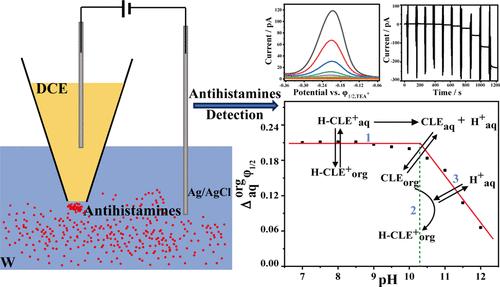当前位置:
X-MOL 学术
›
Anal. Chem.
›
论文详情
Our official English website, www.x-mol.net, welcomes your
feedback! (Note: you will need to create a separate account there.)
Microliquid/Liquid Interfacial Sensors: Biomimetic Investigation of Transmembrane Mechanisms and Real-Time Determinations of Clemastine, Cyproheptadine, Epinastine, Cetirizine, and Desloratadine
Analytical Chemistry ( IF 6.7 ) Pub Date : 2024-04-19 , DOI: 10.1021/acs.analchem.3c05640 Zhidan Xu 1 , Yongtao You 1 , Silan Bai 1 , Lishi Wang 1 , Cheng Liu 2
Analytical Chemistry ( IF 6.7 ) Pub Date : 2024-04-19 , DOI: 10.1021/acs.analchem.3c05640 Zhidan Xu 1 , Yongtao You 1 , Silan Bai 1 , Lishi Wang 1 , Cheng Liu 2
Affiliation

|
Antihistamines relieve allergic symptoms by inhibiting the action of histamine. Further understanding of antihistamine transmembrane mechanisms and optimizing the selectivity and real-time monitoring capabilities of drug sensors is necessary. In this study, a micrometer liquid/liquid (L/L) interfacial sensor has served as a biomimetic membrane to investigate the mechanism of interfacial transfer of five antihistamines, i.e., clemastine (CLE), cyproheptadine (CYP), epinastine (EPI), desloratadine (DSL), and cetirizine (CET), and realize the real-time determinations. Cyclic voltammetry (CV) and differential pulse voltammetry (DPV) techniques have been used to uncover the electrochemical transfer behavior of the five antihistamines at the L/L interface. Additionally, finite element simulations (FEMs) have been employed to reveal the thermodynamics and kinetics of the process. Visualization of antihistamine partitioning in two phases at different pH values can be realized by ion partition diagrams (IPDs). The IPDs also reveal the transfer mechanism at the L/L interface and provide effective lipophilicity at different pH values. Real-time determinations of these antihistamines have been achieved through potentiostatic chronoamperometry (I–t), exhibiting good selectivity with the addition of nine common organic or inorganic compounds in living organisms and revealing the potential for in vivo pharmacokinetics. Besides providing a satisfactory surrogate for studying the transmembrane mechanism of antihistamines, this work also sheds light on micro- and nano L/L interfacial sensors for in vivo analysis of pharmacokinetics at a single-cell or single-organelle level.
中文翻译:

微液/液体界面传感器:跨膜机制的仿生研究以及氯马斯汀、赛庚啶、依匹斯汀、西替利嗪和地氯雷他定的实时测定
抗组胺药通过抑制组胺的作用来缓解过敏症状。有必要进一步了解抗组胺跨膜机制并优化药物传感器的选择性和实时监测能力。在本研究中,微米液/液(L/L)界面传感器作为仿生膜来研究五种抗组胺药的界面转移机制,即氯马斯汀(CLE)、赛庚啶(CYP)、依匹斯汀(EPI)、地氯雷他定(DSL)、西替利嗪(CET),并实现实时测定。循环伏安法 (CV) 和差分脉冲伏安法 (DPV) 技术已用于揭示五种抗组胺药在 L/L 界面处的电化学转移行为。此外,有限元模拟(FEM)已被用来揭示该过程的热力学和动力学。可以通过离子分配图 (IPD) 实现不同 pH 值下抗组胺药分配两相的可视化。 IPD 还揭示了 L/L 界面的转移机制,并在不同 pH 值下提供有效的亲脂性。这些抗组胺药的实时测定是通过恒电位计时安培法( I - t )实现的,在活体生物体中添加九种常见的有机或无机化合物时表现出良好的选择性,并揭示了体内药代动力学的潜力。除了为研究抗组胺药的跨膜机制提供令人满意的替代品外,这项工作还揭示了微米和纳米 L/L 界面传感器用于单细胞或单细胞器水平的体内药代动力学分析。
更新日期:2024-04-19
中文翻译:

微液/液体界面传感器:跨膜机制的仿生研究以及氯马斯汀、赛庚啶、依匹斯汀、西替利嗪和地氯雷他定的实时测定
抗组胺药通过抑制组胺的作用来缓解过敏症状。有必要进一步了解抗组胺跨膜机制并优化药物传感器的选择性和实时监测能力。在本研究中,微米液/液(L/L)界面传感器作为仿生膜来研究五种抗组胺药的界面转移机制,即氯马斯汀(CLE)、赛庚啶(CYP)、依匹斯汀(EPI)、地氯雷他定(DSL)、西替利嗪(CET),并实现实时测定。循环伏安法 (CV) 和差分脉冲伏安法 (DPV) 技术已用于揭示五种抗组胺药在 L/L 界面处的电化学转移行为。此外,有限元模拟(FEM)已被用来揭示该过程的热力学和动力学。可以通过离子分配图 (IPD) 实现不同 pH 值下抗组胺药分配两相的可视化。 IPD 还揭示了 L/L 界面的转移机制,并在不同 pH 值下提供有效的亲脂性。这些抗组胺药的实时测定是通过恒电位计时安培法( I - t )实现的,在活体生物体中添加九种常见的有机或无机化合物时表现出良好的选择性,并揭示了体内药代动力学的潜力。除了为研究抗组胺药的跨膜机制提供令人满意的替代品外,这项工作还揭示了微米和纳米 L/L 界面传感器用于单细胞或单细胞器水平的体内药代动力学分析。


















































 京公网安备 11010802027423号
京公网安备 11010802027423号